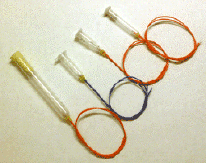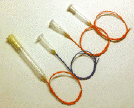 Ejection Canisters
Ejection Canisters Ejection Canisters
Ejection Canisters
Most model rockets deploy their recovery systems with some sort of gas generator that creates a quantity of hot gas and pressurizes a compartment in the rocket, forcing it to open and allow the parachute or streamer to deploy. Usually this system is built into the rocket motor, the familiar "ejection charge." A motor ejection charge is activated after the motor's thrust phase is complete and a delay train has burned through. You select the delay based on the size and weight of the rocket, the weather conditions, and other factors.
Many rockets now use electronic ejection systems. These are usually
altimeters, devices that sense the altitude
 above ground level that the rocket
has traveled. They can sense this by measuring air pressure, measuring
acceleration, or even sensing the Earth's magnetic field. When they detect peak
altitude, they send an electrical pulse to fire a gas generator and deploy the
recovery system. Many of them can do this more than once; in large rockets, it's
common to deploy a small drogue parachute or streamer at high altitude, fall
rapidly to a lower altitude, and deploy a nice big parachute low enough that the
wind won't blow the rocket into the next county.
above ground level that the rocket
has traveled. They can sense this by measuring air pressure, measuring
acceleration, or even sensing the Earth's magnetic field. When they detect peak
altitude, they send an electrical pulse to fire a gas generator and deploy the
recovery system. Many of them can do this more than once; in large rockets, it's
common to deploy a small drogue parachute or streamer at high altitude, fall
rapidly to a lower altitude, and deploy a nice big parachute low enough that the
wind won't blow the rocket into the next county.
These electronic deployment systems require some method of igniting a charge of propellant to generate the gas that drives the recovery system. Our Ejection Canisters are designed to fill this need.
 Pratt Hobbies Ejection Canisters are plastic containers that come wired with
an ignition filament in the bottom. These filaments have been tested with all of
the commercially-available electronic deployment systems. They require very
little voltage and current to ignite the recovery propellant. Unlike common
rocket motor igniters, squibs, or "electric matches," our filaments have no
chemical coating. They are not subject to explosives regulations or storage
requirements. They are not sensitive to static electricity or sparks.
Pratt Hobbies Ejection Canisters are plastic containers that come wired with
an ignition filament in the bottom. These filaments have been tested with all of
the commercially-available electronic deployment systems. They require very
little voltage and current to ignite the recovery propellant. Unlike common
rocket motor igniters, squibs, or "electric matches," our filaments have no
chemical coating. They are not subject to explosives regulations or storage
requirements. They are not sensitive to static electricity or sparks.
Each Ejection Canister is tested for continuity as it is assembled in our shop. We write the resistance in ohms on each canister before it is bagged. You can verify the Canister's condition by testing it with a multimeter. If the resistance is different from the value written on the Canister by 5 ohms or more, we will replace it free.
We offer Ejection Canisters in four sizes:
 Compact Ejection Canisters (CEC-5) come in packs of five. The Canister is a
narrow tube, small enough to fit in rockets of 18mm in diameter. The CEC will
accept between 1/10 and 8/10 of a gram of propellant; the foam plug slides into
the tube to make sure the propellant is held against the filament.
CEC-5 , $9.00
for a pack of 5 in a tamper-proof ziplock bag.
Compact Ejection Canisters (CEC-5) come in packs of five. The Canister is a
narrow tube, small enough to fit in rockets of 18mm in diameter. The CEC will
accept between 1/10 and 8/10 of a gram of propellant; the foam plug slides into
the tube to make sure the propellant is held against the filament.
CEC-5 , $9.00
for a pack of 5 in a tamper-proof ziplock bag.
 Standard Ejection Canisters
(SEC-5) have made thousands of flights in the last eight
years. The SEC-5 is a plastic container with a snap cap that holds 1.15 grams of
propellant. They are recommended for rockets 2 to 4 inches in diameter.
SEC-5,
$10.00 for a pack of 5 in a tamper-proof ziplock bag.
Standard Ejection Canisters
(SEC-5) have made thousands of flights in the last eight
years. The SEC-5 is a plastic container with a snap cap that holds 1.15 grams of
propellant. They are recommended for rockets 2 to 4 inches in diameter.
SEC-5,
$10.00 for a pack of 5 in a tamper-proof ziplock bag.
 Large Ejection Canisters
(LEC-5) are for rockets with larger recovery compartments or
more volume to pressurize. They are plastic containers with snap caps that hold
1.5 grams of propellant. LEC-5, $12.00 for a pack of 5 in a tamper-proof ziplock
bag.
Large Ejection Canisters
(LEC-5) are for rockets with larger recovery compartments or
more volume to pressurize. They are plastic containers with snap caps that hold
1.5 grams of propellant. LEC-5, $12.00 for a pack of 5 in a tamper-proof ziplock
bag.
 XL Variable
Capacity Ejection Canisters are for very large models. They can hold as much
as 30 grams of propellant. Because the foam plug can seal the tube at any point,
XLEC canisters can hold as little as 1 gram, but the other Canisters are more
appropriate for this amount of propellant.
XLEC-1, $2.25 each.
XL Variable
Capacity Ejection Canisters are for very large models. They can hold as much
as 30 grams of propellant. Because the foam plug can seal the tube at any point,
XLEC canisters can hold as little as 1 gram, but the other Canisters are more
appropriate for this amount of propellant.
XLEC-1, $2.25 each.
The most commonly used propellant in ejection systems is FFFG Black Powder (BP). A one pound can of Black Powder will last a long time, and many clubs share them. Black Powder is usually purchased locally, and some cities and states have regulations limiting who can buy BP. On the other hand, it is not uncommon to find BP at stores like Wal-Mart.
There are several brands of propellant on the market that are designed to be Black Powder replacements. The most common is Pyrodex. Pyrodex is usually not subject to the restrictions that Black Powder may be; you should be able to order Pyrodex through online services like Midway USA or Amazon.com. However, Pyrodex does not have exactly the same burn characteristics as Black Powder. Several years ago we conducted tests to see if Pyrodex could be used in our Ejection Canisters. We found that Pyrodex works very well, as long as it is more tightly contained. Loading an Ejection Canister with Pyrodex and wrapping it tightly with one layer of PVC tape is all that is needed. Here are some video clips and information on our tests.
Smokeless powders used for reloading ammunition will not work in Ejection Canisters. Use only Black Powder or a Black Powder Substitute like Pyrodex. Do not use pelletized propellants, such as the Pyrodex Pellets used to ignite Contrail hybrid rocket motors, in an ejection charge system.
IMPORTANT: Fill the Ejection Canister completely with black powder. Use 3FG powder or finer; 4FG is best. Powder MUST touch the igniter for reliable ignition. Black powder can "bridge" or clump, so tap the Canister and look carefully to make sure the powder is in contact with the filament in the base.
| Never load an Ejection Canister until you are getting ready to fly. | |
| Make certain that the propellant (BP or Pyrodex) is held in place against the filament in the bottom of the Ejection Canister. | |
| If you load a Canister and don't use it, empty it on the field before you pack up to leave. Never store Canisters loaded! | |
| Ejection Canisters don't have to be pointed in a particular direction or secured in the rocket. | |
| The only part of the Canister that needs to be secured is the wiring. Make certain that the wires will not be pulled or dragged out of the connections on the altimeter during flight. | |
| Before loading, test each Ejection Canister by connecting the wires to a multimeter and measuring the resistance in ohms. Compare the measurement to the value written on the Canister. If there is more than 5 ohms difference, return the Canister to us for a free replacement. Do not fly it. |